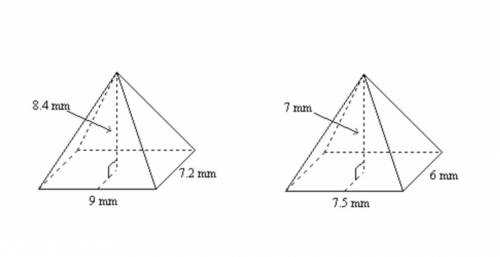 1
1 answered in comments :)
Step-by-step explanation:
 1
1 answered in comments :)
Step-by-step explanation:
9514 1404 393
JKLM ~ QRSP, scale factor 0.6ΔABC ~ ΔUVT, scale factor 1.5Step-by-step explanation:
We can write the similarity statements by naming vertices in order of increasing numbers of arcs, starting with the one having a single arc. Then we can express the side lengths as a reduced ratio, in the same order.
1. JKLM ~ QRSP
JK : KL : LM : MJ = 20 : 15 : 24 : 25
QR : RS : SP : PQ = 12 : 9 : 14.4 : 15 = 20 : 15 : 24 : 25 (same ratios)
The scale factor is 12/20 = 0.6.
__
2. ΔABC ~ ΔUVT
AB : BC : CA = 16 : 14 : 12 = 8 : 7 : 6
UV : VT : TU = 24 : 21 : 18 = 8 : 7 : 6 (same ratios)
The scale factor is 24/16 = 1.5.

 2
2 Option (2)
Step-by-step explanation:
Two triangle are similar when,
1). Two or more than two angles of the given triangles are equal in measure.
2). Ratio of the corresponding sides are same.
In the triangles ΔDEF and ΔBAC,
m(∠A) = m(∠E) = 58°
m(∠B) = m(∠D) = 53°
m(∠C) = m(∠F) = 69°
And ratio of the corresponding sides,



Therefore, ΔDEF ~ ΔBAC
Option (2) will be the answer.
 2
2 Option (2)
Step-by-step explanation:
Two triangle are similar when,
1). Two or more than two angles of the given triangles are equal in measure.
2). Ratio of the corresponding sides are same.
In the triangles ΔDEF and ΔBAC,
m(∠A) = m(∠E) = 58°
m(∠B) = m(∠D) = 53°
m(∠C) = m(∠F) = 69°
And ratio of the corresponding sides,



Therefore, ΔDEF ~ ΔBAC
Option (2) will be the answer.
 6
6 Explanation:
This table shows the measures of the angles of the triangles BAC and DEG in the same order of vertices as indicated by letters:
Triangle BAC: Triangle DEF
Measure angle B = 20° measure angle D = 20°Measure angle A = 120° measure angle E = 120°Measure angle C = 40° measure angle F = 40°There you see the measure of vertix B is equal to that of vertix D, the measure of vertix A is equal to that of vertix F, and the measure of vertex C is equal to that of vertix F, hence the corresponding vertices are congruents, which means that the triangles are similar.
When you look at the corresponding sides they are also congruent:
Triangle BAC: Triangle DEF
Length side AB = 6.3 Length side DE = 6.3Length side BC = 8.6 Length side DF = 8.6Measure angle CA = 3.5 Length side EF = 3.5Thus, the ratios of the corresponding sides are 6.3/6.3 = 8.6/8.6 = 3.5/3.5 = 1.
Therefore, the last choice shows the correct conclusion about the similarity of that pair of figures: triangles BAC and DEF are similar and the ratio of the corresponding sides is 1.
 9
9 9514 1404 393
JKLM ~ QRSP, scale factor 0.6ΔABC ~ ΔUVT, scale factor 1.5Step-by-step explanation:
We can write the similarity statements by naming vertices in order of increasing numbers of arcs, starting with the one having a single arc. Then we can express the side lengths as a reduced ratio, in the same order.
1. JKLM ~ QRSP
JK : KL : LM : MJ = 20 : 15 : 24 : 25
QR : RS : SP : PQ = 12 : 9 : 14.4 : 15 = 20 : 15 : 24 : 25 (same ratios)
The scale factor is 12/20 = 0.6.
__
2. ΔABC ~ ΔUVT
AB : BC : CA = 16 : 14 : 12 = 8 : 7 : 6
UV : VT : TU = 24 : 21 : 18 = 8 : 7 : 6 (same ratios)
The scale factor is 24/16 = 1.5.

 10
10 Neither
Step-by-step explanation:
Can be determined because there is enough information (Length, width, and height).
Not congruent because from the picture itself, the figures are in different sizes.
Not similar because:
The height ratio is not the same as the ratios of other dimensions.
1 : 4 is not similar to 6 : 12 and 4 : 8
 9
9 They are similar but not congruent.
the two shapes are similar, because they are both pyramids with the same ratio of dimensions.
But they are not congruent because the ratios are not equal to 1.
Step-by-step explanation:
Using the shapes in the attached image we want to confirm if they are similar or congruent.
From the image we can see that they are both pyramids
To compare the two pyramids
Pyramid 1
Height h = 8.4mm
Length l = 9.0mm
Breadth b = 7.2mm
Pyramid 2
h = 7mm
l = 7.5mm
b = 6mm
For the two pyramids to be similar, the sides must have the same ratio.
For the two pyramids to be congruent, the ratio of their dimensions must be equal to 1
Ratio
h = h1/h2 = 8.4/7 = 1.2
l = l1/l2 = 9/7.5 = 1.2
b = b1/b2 = 7.2/6 = 1.2
Therefore the two shapes are similar, because they are both pyramids with the same ratio of dimensions.
But they are not congruent because the ratio is not equal to 1.


It will provide an instant answer!
